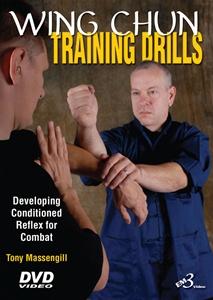Review of Tony Massengill's Wing Chun Training Drills DVD
Customer/3rd Party Review: This review was done by a customer/3rd party and is listed here for you reference only. The views and opinions of the reviewer are not those of Everything Wing Chun and do not necessarily reflect EWC's views or opinions on the subject matter. It is posted, like all customer reviews, to give you more info on the product and to give you different opinions on a product so that you can make the best decision for yourself about its content. The review is NOT by an EWC employee or contractor and EWC cannot stand by anything said in any customer/3rd party review. Enjoy!
Reviewer: George Hernandez
Date: May 14, 2011
DVD Bought on: Everything Wing Chun : http://www.everythingwingchun.com/tony-massengill-wing-chun-dvds-books-s/244.htm
Technical Specifications:
Title: Tony Massengill Wing Chun Training Drills
DVD Length: 1 hour 18 mins
Region: 0
Type: DVD-R
Format: NTSC
Video Quality: Above Average
Audio Quality: 5/5 (Professional)
What It's About:
Sifu Tony Massengill presents Wing Chun training drills to develop conditioned reflexes for combat.
Comments:
Before you can apply close range technique in a fighting situation one must drill properly in order to make it work. Sifu Massengill presents superbly, the basics in performing the drills associated with close range fighting in the Wing Chun system.
Fundamental in this skill development of close range fighting comes from understanding the rudiments of the drill’s structure. This is excellent advice, since it’s important to know what the drill is to achieve in practice. Drills, done properly can quicken learning, particularly in the technique’s execution and gives one a true feel in discovering how it works.
Applications performed during training drills depend on one’s structure as well as the structure of the other person; one must also consider other factors which affect performance in the drill. For example, not only structure, but how one’s distance and point of contact with the other person are achieved during the drill. This is probably an obvious point, since if you’re a short person practicing with someone who is taller, the drill is going to work slightly different---one has to compensate for the difference. Of course, how one adjust for such differences in size and weight of an opponent can only be achieved during drills which give you the opportunity to use technique in such a situation.
Sifu Massengill, gives an excellent presentation of how drills and technique work based on sound principles of Wing Chun. He shows the practitioner where the drill actually starts and follows through in its sequences. In training he said, “train and use what has merit.” That’s excellent advice! Simply put…does it work and does it work for you! Sifu’s demonstration of technique is impressive during the training drill sequences offering a clear understanding of the Wing Chun principles applied. This is an excellent DVD to be taught the concepts and practice of drills leading to skill development in applying the various hand forms of the Wing Chun system.
Content Overview:
Introduction
Developing conditioned reflex for combat based on the principle of the need to react.
- Designed for training reflex.
- The need to react.
- A drill is repetitive.
- The structure of the drill
- Where the drill starts.
- When to relax the arm.
- Shifting the body during the drill.
- The sticking hand vs the hand that disengages.
- The position of the elbow.
- Drill sequences.
- The Pac Sao hand.
- The Wu Sao hand
- Fook Sao hand
- The Bong Sao Drill.
- Tan Da with a shifting horse
- Lop Sao Sequence.
- Chi Sao Training.
- The position of the hands in partner practice.
- Structure is important.
- The elbow and centerline.
- The Huan Sao and elbow.
- The running hand.
- The outside Jet Sao.
- Using the Bong Sao.
- Double hand chi Sao is not competition.
- Turning and getting access to the inside.
- What is the single response cycle.
- What is the multiple response cycle.
- Using the angles.
- Training for chain punching
- Defense against kicks.
- The life cycle of a kick.
- Using the Quan Sao Hand and leg.
- The mistake of receiving a kick during its full maturity,
- Catching the kick early using a Gum Sao hand.
- Stepping to the side.
- Kicking at the opponents supporting leg.
other blogs by user


